ASTP (original) (raw)

Home - Search - Browse - Alphabetic Index: 0- 1- 2- 3- 4- 5- 6- 7- 8- 9
A- B- C- D- E- F- G- H- I- J- K- L- M- N- O- P- Q- R- S- T- U- V- W- X- Y- Z
ASTP
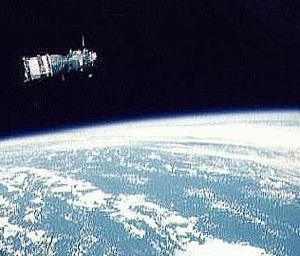
Soyuz ASTP in Orbit
Credit: NASA
Apollo-Soyuz Test Project. Meetings began in 1969 between Russian and American representatives on a joint manned space mission. Ambitious plans for use of Skylab or Salyut space stations were not approved. Instead it was decided to develop a universal docking system for space rescue. A working group was set up in October 1970 and in May 1972 the USA/USSR Agreement was signed with launch to take place in 1975. D Bushuev and G Lanin were the technical directors of the Soviet-designed EPAS docking system program. 1600 experiments were conducted in developing the system.
Subtopics
| Soyuz 16 ASTP Manned Test Flight. Check-out of the Soyuz systems modified for Apollo-Soyuz docking in space. |
|---|
| Apollo (ASTP) First international joint manned space mission; first docking between two spacecraft launched from different countries. Crew nearly killed by toxic propellant vapors dumped into the cabin air supply during re-entry. |
|---|
| Soyuz 19 (ASTP) First docking between two spacecraft launched from different nations. Culmination of the Apollo-Soyuz Test Project, a post-moon race 'goodwill' flight to test a US/Soviet common docking system. |
|---|
| Soyuz 22 Surplus Soyuz ASTP spacecraft modified with a multi-spectral camera manufactured by Carl Zeiss-Jena in place of the universal docking apparatus. Eight days were spent photographing the earth. |
|---|
People: Slayton, Filipchenko, Stafford, Brand, Bean, Rukavishnikov, Evans, Leonov, Bykovsky, Kubasov, Aksyonov, Lousma, Ivanchenkov, Andreyev, Strekalov, Malyshev, Dzhanibekov, Romanenko, Popov. Country: USA, Russia. Spacecraft: Apollo CSM, Soyuz 7K-TM, Apollo ASTP Docking Module, Soyuz 7K-MF6. Flights: Soyuz 16, Apollo (ASTP), Soyuz 19 (ASTP), Soyuz 22. Launch Vehicles: Saturn IB, Soyuz-U.
Photo Gallery
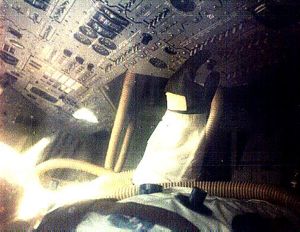 |
Apollo CSM InteriorInterior of the Apollo Command Service Module on display at Kennedy Space Centre, Florida.Credit: © Mark Wade |
|---|
 |
Soyuz ASTPCredit: © Mark Wade |
|---|
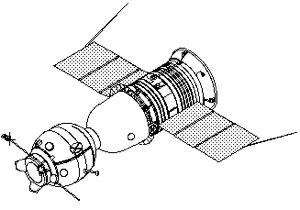 |
Soyuz ASTPCredit: © Mark Wade |
|---|
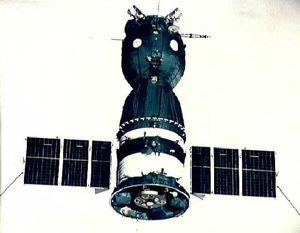 |
Soyuz ASTP in Orbit Soyuz ASTP in Orbit 3Credit: NASA |
|---|
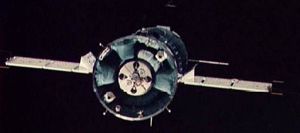 |
Soyuz ASTP in Orbit Soyuz ASTP in Orbit 4Credit: NASA |
|---|
 |
Apollo CSMApollo CSM with Launch Escape TowerCredit: © Mark Wade |
|---|
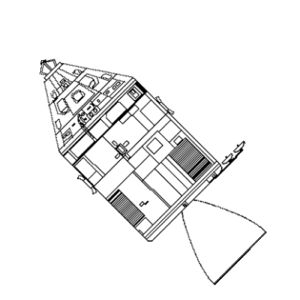 |
Apollo CSMCredit: © Mark Wade |
|---|
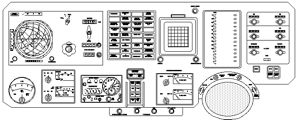 |
Panel Soyuz 7K-OKControl panel of the initial earth orbit version of Soyuz.Credit: © Mark Wade |
|---|
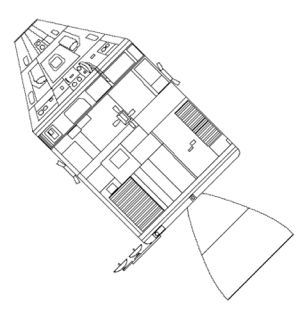 |
Apollo CSMCredit: © Mark Wade |
|---|
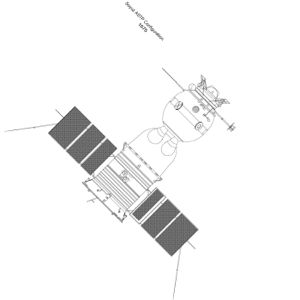 |
Soyuz ASTPCredit: © Mark Wade |
|---|
 |
APAS-75 docking unitAPAS-75 docking unit as used in ASTP project.Credit: Andy Salmon |
|---|
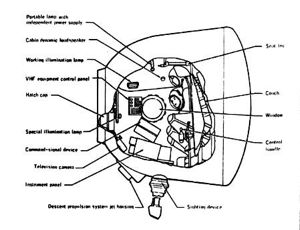 |
Soyuz ASTP SACutaway of Soyuz re-entry capsule. |
|---|
 |
Soyuz ASTP BOCutaway of Soyuz orbital module. |
|---|
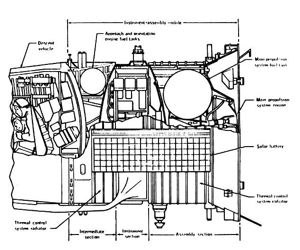 |
Soyuz ASTP POCutaway of Soyuz equipment / propulsion module. |
|---|
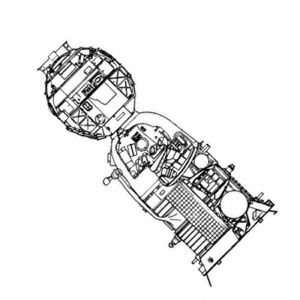 |
Soyuz ASTP Cutaway |
|---|
1970 May 15 - .
- Soviet view on space cooperation conference. - . Nation: Russia. Program: ASTP. Kamanin meets with Muravev, who attended a Congress for Joint US-USSR Space Cooperation in America. He told of protests in America against Nixon's aggression in Cambodia..
1970 October 14 - .
- Contacts on join USA/USSR docking system. - . Nation: Russia. Related Persons: Keldysh, Nikolayev, Sevastyanov. Program: ASTP. Spacecraft Bus: Soyuz. Spacecraft: Soyuz 7K-TM.
Communist Party Meeting at the cosmonaut centre. Keldysh calls later. Six specialists are to be sent to the United States to discuss design of a common USA/USSR docking system. Kamanin yet again goes through the correct answers and prepared speeches to be given to the press by Nikolayev and Sevastyanov on their visit to West Germany.
1973 September 15 - .
- Television programs not recommended for ASTP. - . Nation: USA. Program: ASTP. Flight: Apollo (ASTP). The Director of the Skylab Program, in offered his counterpart in the ASTP some advice in establishing an ASTP television program.. Additional Details: here....
1974 April 3 - . 07:30 GMT - . Launch Site: Baikonur. Launch Complex: Baikonur LC31. LV Family: R-7. Launch Vehicle: Soyuz-U.
- Cosmos 638 - . Payload: Soyuz ASTP s/n 71-EPSA. Mass: 6,570 kg (14,480 lb). Nation: Russia. Agency: MOM. Program: ASTP. Class: Manned. Type: Manned spacecraft. Spacecraft Bus: Soyuz. Spacecraft: Soyuz 7K-TM. Duration: 9.89 days. Decay Date: 1974-04-13 . USAF Sat Cat: 7234 . COSPAR: 1974-018A. Apogee: 309 km (192 mi). Perigee: 187 km (116 mi). Inclination: 51.80 deg. Period: 89.40 min.
Unmanned Soyuz test flight. Recovered April 13, 1974 5:05 GMT. Soyuz ASTP Test.
Maneuver Summary:
190km X 309km orbit to 190km X 266km orbit. Delta V: 12 m/s
190km X 266km orbit to 240km X 300km orbit. Delta V: 23 m/s
240km X 300km orbit to 258km X 274km orbit. Delta V: 12 m/s
Total Delta V: 47 m/s.
Officially: Investigation of the upper atmosphere and outer space.
1974 August 12 - . 06:25 GMT - . Launch Site: Baikonur. Launch Complex: Baikonur LC31. LV Family: R-7. Launch Vehicle: Soyuz-U.
- Cosmos 672 - . Payload: Soyuz ASTP s/n 72-EPSA. Mass: 6,570 kg (14,480 lb). Nation: Russia. Agency: MOM. Program: ASTP. Class: Manned. Type: Manned spacecraft. Spacecraft Bus: Soyuz. Spacecraft: Soyuz 7K-TM. Duration: 5.94 days. Decay Date: 1974-08-18 . USAF Sat Cat: 7413 . COSPAR: 1974-064A. Apogee: 226 km (140 mi). Perigee: 222 km (137 mi). Inclination: 51.70 deg. Period: 88.90 min.
ASTP precursor. Recovered August 18, 1974 5:02 GMT. Soyuz ASTP test.
Maneuver Summary:
195km X 305km orbit to 195km X 221km orbit. Delta V: 24 m/s
195km X 221km orbit to 223km X 223km orbit. Delta V: 8 m/s
231km X 231km orbit to 231km X 231km orbit. Delta V: 1 m/s
223km X 223km orbit to 231km X 231km orbit. Delta V: 4 m/s
231km X 231km orbit to 227km X 237km orbit. Delta V: 2 m/s
Total Delta V: 39 m/s.
Officially: Investigation of the upper atmosphere and outer space.
1974 December 2 - . 09:40 GMT - . Launch Site: Baikonur. Launch Complex: Baikonur LC1. LV Family: R-7. Launch Vehicle: Soyuz-U.
- Soyuz 16 - . Call Sign: Buran (Snowstorm ). Crew: Filipchenko, Rukavishnikov. Backup Crew: Andreyev, Dzhanibekov. Support Crew: Ivanchenkov, Romanenko. Payload: Soyuz ASTP s/n 73-EPSA. Mass: 6,800 kg (14,900 lb). Nation: Russia. Agency: MOM. Program: ASTP. Class: Manned. Type: Manned spacecraft. Flight: Soyuz 16. Spacecraft Bus: Soyuz. Spacecraft: Soyuz 7K-TM. Duration: 5.93 days. Decay Date: 1974-12-08 . USAF Sat Cat: 7561 . COSPAR: 1974-096A. Apogee: 291 km (180 mi). Perigee: 184 km (114 mi). Inclination: 51.80 deg. Period: 89.20 min.
ASTP Manned Test Flight. Check-out of the Soyuz space craft's on-board systems which had been modernized to meet the requirements of the 1975 joint flight in accordance with the programme of the Soviet-United States experiment; conduct of scientific and technical investigations.
1974 December 8 - .
- Landing of Soyuz 16 - . Return Crew: Filipchenko, Rukavishnikov. Nation: Russia. Related Persons: Filipchenko, Rukavishnikov. Program: ASTP. Flight: Soyuz 16. Soyuz 16 landed at 08:04 GMT, 30 km NE of Arkalyk..
1975 July 15 - . 12:20 GMT - . Launch Site: Baikonur. Launch Complex: Baikonur LC1. LV Family: R-7. Launch Vehicle: Soyuz-U.
- Soyuz 19 (ASTP) - . Call Sign: Soyuz (Union ). Crew: Kubasov, Leonov. Backup Crew: Filipchenko, Rukavishnikov. Support Crew: Andreyev, Dzhanibekov, Ivanchenkov, Romanenko. Payload: Soyuz ASTP s/n 75 (EPSA). Mass: 6,790 kg (14,960 lb). Nation: Russia. Agency: MOM. Program: ASTP. Class: Manned. Type: Manned spacecraft. Flight: Apollo (ASTP), Soyuz 19 (ASTP). Spacecraft Bus: Soyuz. Spacecraft: Soyuz 7K-TM. Duration: 5.94 days. Decay Date: 1975-07-21 . USAF Sat Cat: 8030 . COSPAR: 1975-065A. Apogee: 220 km (130 mi). Perigee: 186 km (115 mi). Inclination: 51.80 deg. Period: 88.50 min.
Soyuz 19 initial orbital parameters were 220.8 by 185.07 kilometres, at the desired inclination of 51.80�, while the period of the first orbit was 88.6 minutes. On 17 July the two spacecraft docked. The crew members rotated between the two spacecraft and conducted various mainly ceremonial activities. Leonov was on the American side for 5 hours, 43 minutes, while Kubasov spent 4:57 in the command and docking modules.
After being docked for nearly 44 hours, Apollo and Soyuz parted for the first time and were station-keeping at a range of 50 meters. The Apollo crew placed its craft between Soyuz and the sun so that the diameter of the service module formed a disk which blocked out the sun. After this experiment Apollo moved towards Soyuz for the second docking.
Three hours later Apollo and Soyuz undocked for the second and final time. The spacecraft moved to a 40 m station-keeping distance so that an ultraviolet absorption experiment could be performed. With all the joint flight activities completed, the ships went on their separate ways.
1975 July 15 - . 19:50 GMT - . Launch Site: Cape Canaveral. Launch Complex: Cape Canaveral LC39B. Launch Platform: LUT1. LV Family: Saturn I. Launch Vehicle: Saturn IB.
- Apollo (ASTP) - . Call Sign: Apollo. Crew: Brand, Slayton, Stafford. Backup Crew: Bean, Evans, Lousma. Payload: Apollo CSM 111. Mass: 14,768 kg (32,557 lb). Nation: USA. Agency: NASA Houston. Program: ASTP. Class: Moon. Type: Manned lunar spacecraft. Flight: Apollo (ASTP), Soyuz 19 (ASTP). Spacecraft: Apollo CSM. Duration: 9.06 days. Decay Date: 1975-07-24 . USAF Sat Cat: 8032 . COSPAR: 1975-066A. Apogee: 166 km (103 mi). Perigee: 152 km (94 mi). Inclination: 51.70 deg. Period: 87.60 min.
This flight marked the culmination of the Apollo-Soyuz Test Project, a post-moon race 'goodwill' flight to test a common docking system for space rescue. 15 July 1975 began with the flawless launch of Soyuz 19. Apollo followed right on schedule. Despite a stowaway - a 'super Florida mosquito' - the crew accomplished a series of rendezvous manoeuvres over the next day resulting in rendezvous with Soyuz 19. At 11:10 on 17 July the two spacecraft docked. The crew members rotated between the two spacecraft and conducted various mainly ceremonial activities. Stafford spent 7 hours, 10 minutes aboard Soyuz, Brand 6:30, and Slayton 1:35. Leonov was on the American side for 5 hours, 43 minutes, while Kubasov spent 4:57 in the command and docking modules.
After being docked for nearly 44 hours, Apollo and Soyuz parted for the first time and were station-keeping at a range of 50 meters. The Apollo crew placed its craft between Soyuz and the sun so that the diameter of the service module formed a disk which blocked out the sun. This artificial solar eclipse, as viewed from Soyuz, permitted photography of the solar corona. After this experiment Apollo moved towards Soyuz for the second docking.
Three hours later Apollo and Soyuz undocked for the second and final time. The spacecraft moved to a 40 m station-keeping distance so that the ultraviolet absorption (UVA MA-059) experiment could be performed. This was an effort to more precisely determine the quantities of atomic oxygen and atomic nitrogen existing at such altitudes. Apollo, flying out of plane around Soyuz, projected monochromatic laser-like beams of light to retro-reflectors mounted on Soyuz. On the 150-meter phase of the experiment, light from a Soyuz port led to a misalignment of the spectrometer, but on the 500-meter pass excellent data were received; on the 1,000-meter pass satisfactory results were also obtained.
With all the joint flight activities completed, the ships went on their separate ways. On 20 July the Apollo crew conducted earth observation, experiments in the multipurpose furnace (MA-010), extreme ultraviolet surveying (MA-083), crystal growth (MA-085), and helium glow (MA-088). On 21 July Soyuz 19 landed safely in Kazakhstan. Apollo continued in orbit on 22-23 July to conduct 23 independent experiments - including a doppler tracking experiment (MA-089) and geodynamics experiment (MA-128) designed to verify which of two techniques would be best suited for studying plate tectonics from earth orbit.
After donning their space suits, the crew vented the command module tunnel and jettisoned the docking module. The docking module would continue on its way until it re-entered the earth's atmosphere and burned up in August 1975. - Saturn S-IVB-210 - . Payload: Saturn S-IVB-210. Nation: USA. Agency: NASA Huntsville. Program: ASTP. Decay Date: 1975-07-16 . USAF Sat Cat: 8033 . COSPAR: 1975-066B. Apogee: 166 km (103 mi). Perigee: 152 km (94 mi). Inclination: 51.70 deg. Period: 87.60 min.
- Docking Module 2 - . Payload: Apollo DM-2. Mass: 2,012 kg (4,435 lb). Nation: USA. Agency: NASA Houston. Program: ASTP. Spacecraft Bus: Apollo CSM. Spacecraft: Apollo ASTP Docking Module. Decay Date: 1975-08-02 . USAF Sat Cat: 8042 . COSPAR: 1975-066C. Apogee: 222 km (137 mi). Perigee: 201 km (124 mi). Inclination: 51.70 deg. Period: 88.73 min.
1975 July 16 - .
- ASTP - Rendezvous Maneuvers - . Nation: USA. Program: ASTP. Flight: Apollo (ASTP), Soyuz 19 (ASTP). Apollo and Soyuz modify their orbits in preparation for the docking in space planned for the next day.. Additional Details: here....
1975 July 17 - .
- ASTP - The 'Handshake in Space'. - . Nation: USA. Program: ASTP. Flight: Apollo (ASTP), Soyuz 19 (ASTP). Apollo and Soyuz successfully dock and members of the American and Russian crews shake hands in space for the first time. With the Soviet-American d�tente crumbling, it will be the last such docking for 20 years.. Additional Details: here....
1975 July 18 - .
- ASTP-Crew transfers between the docked vehicles. - . Nation: USA. Program: ASTP. Flight: Apollo (ASTP), Soyuz 19 (ASTP).
The crew members take turns visiting each other's capsules, a complicated procedure due to the need to keep both spacecraft manned at all times and for the transfer crews to transition in the docking module between the different Soyuz and Apollo cabin atmospheres. Additional Details: here....
1975 July 19 - .
- ASTP - Joint Apollo/Soyuz flight activities - . Nation: USA. Program: ASTP. Flight: Apollo (ASTP), Soyuz 19 (ASTP).
During day five of the flight, the crews concentrated on docking exercises and experiments that involved the two ships in the undocked mode. During the interval between the first undocking and the second docking, the Apollo crew placed its craft between Soyuz and the sun so that the diameter of the service module formed a disk which blocked out the sun. This artificial solar eclipse, as viewed from Soyuz, permitted Leonov and Kubasov to photograph the solar corona. Additional Details: here....
1975 July 20 - .
- ASTP - Separate Apollo/Soyuz activities - . Nation: USA. Program: ASTP. Flight: Apollo (ASTP), Soyuz 19 (ASTP). Apollo and Soyuz, now flying in separate orbits, conduct independent experiments prior to their return to earth.. Additional Details: here....
1975 July 21 - .
- ASTP - Soyuz returns to earth, Apollo remains in orbit. - . Nation: Russia. Program: ASTP. Flight: Apollo (ASTP), Soyuz 19 (ASTP).
Following a rest period of nearly 10 hours, the Soyuz crewmen advised the ground that they were awake and that all systems were normal. The deorbit burn came exactly on time (5:09 in Houston), and the Soyuz crew landed safely in Kazakhstan. For the remaining three and a half days, Stafford, Slayton, and Brand would concentrate on their experiments, but in many respects the saga of Apollo and Soyuz had come to an end.
1975 July 21 - .
- Landing of Soyuz 19 (ASTP) - . Return Crew: Kubasov, Leonov. Nation: Russia. Related Persons: Kubasov, Leonov. Program: ASTP. Flight: Apollo (ASTP), Soyuz 19 (ASTP). Soyuz 19 landed safely at 10:51 GMT, 87 km north-east of Arkalyk, 9. 6 km from its aim point..
1975 July 23 - .
- Apollo (ASTP) in-flight experiments - . Nation: USA. Program: ASTP. Flight: Apollo (ASTP).
Some minor experiment hardware problems developed during the final days of the mission, but for the most part the crew members worked through their flight plan - which included 23 independent experiments - with few difficulties. After a relatively quiet day of work on the 22nd, the major part of the 23rd was devoted to preparing for and conducting the doppler tracking experiment (MA-089). The day was also marked by a press conference from space and jettison of the docking module. Additional Details: here....
1975 July 24 - .
- Landing of Apollo (ASTP) - . Return Crew: Brand, Slayton, Stafford. Nation: USA. Related Persons: Brand, Slayton, Stafford. Program: ASTP. Flight: Apollo (ASTP).
Apollo (ASTP) landed at 21:18 GMT, 7.3 km from the recovery ship New Orleans. It was the last splashdown of an American space capsule. However the flight of the last Apollo spacecraft was marred by the fact that the crew almost perished while the capsule was descending under its parachute.
A failure in switchology led the automatic landing sequence to be not armed at the same time the reaction control system was still active. When the Apollo hadn't begun the parachute deployment sequence by 7,000 metres altitude, Brand hit the manual switches for the apex cover and the drogues. The manual deployment of the drogue chutes caused the CM to sway, and the reaction control system thrusters worked vigorously to counteract that motion. When the crew finally armed the automatic ELS 30 seconds later, the thruster action terminated.
During that 30 seconds, the cabin was flooded with a mixture of toxic unignited propellants from the thrusters. Prior to drogue deployment, the cabin pressure relief valve had opened automatically, and in addition to drawing in fresh air it also brought in unwanted gases being expelled from the roll thrusters located about 0.6 meter from the relief valve. Brand manually deployed the main parachutes at about 2,700 meters despite the gas fumes in the cabin.
By the time of splashdown, the crew was nearly unconscious from the fumes, Stafford managed to get an oxygen mask over Brand's face. He then began to come around. When the command module was upright in the water, Stafford opened the vent valve, and with the in-rush of air the remaining fumes disappeared. The crew ended up with a two-week hospital stay in Honolulu. For Slayton, it also meant the discovery of a small lesion on his left lung and an exploratory operation that indicated it was a non-malignant tumour. Additional Details: here....
1976 September 15 - . 09:48 GMT - . Launch Site: Baikonur. Launch Complex: Baikonur LC1. LV Family: R-7. Launch Vehicle: Soyuz-U.
- Soyuz 22 - . Call Sign: Yastreb (Hawk ). Crew: Aksyonov, Bykovsky. Backup Crew: Malyshev, Strekalov. Support Crew: Andreyev, Popov. Payload: Soyuz ASTP s/n 74 modified with MF6 camera. Mass: 6,510 kg (14,350 lb). Nation: Russia. Agency: MOM. Program: ASTP. Class: Manned. Type: Manned spacecraft. Flight: Soyuz 22. Spacecraft Bus: Soyuz. Spacecraft: Soyuz 7K-MF6. Duration: 7.91 days. Decay Date: 1976-09-23 . USAF Sat Cat: 9421 . COSPAR: 1976-093A. Apogee: 296 km (183 mi). Perigee: 185 km (114 mi). Inclination: 64.80 deg. Period: 89.30 min.
Surplus Soyuz ASTP spacecraft modified with a multi-spectral camera manufactured by Carl Zeiss-Jena in place of the universal docking apparatus. Eight days were spent photographing the earth. Tested and perfected scientific-technical methods and devices for studying the geological characteristics of the earth's surface from outer space for economic purposes.
1976 September 23 - .
- Landing of Soyuz 22 - . Return Crew: Aksyonov, Bykovsky. Nation: Russia. Related Persons: Aksyonov, Bykovsky. Program: ASTP. Flight: Soyuz 22. Soyuz 22 landed at 7:42 GMT, 150 km NW of Tselinograd..
Home - Search - Browse - Alphabetic Index: 0- 1- 2- 3- 4- 5- 6- 7- 8- 9
A- B- C- D- E- F- G- H- I- J- K- L- M- N- O- P- Q- R- S- T- U- V- W- X- Y- Z
© 1997-2019 Mark Wade - Contact
© / Conditions for Use